CO5119 Business Law: Analyzing Civil Liability in a Golf Case
VerifiedAdded on 2023/04/23
|9
|1822
|353
Case Study
AI Summary
This case study examines a civil liability claim arising from a golf course incident where Paul was injured by a golf ball hit by Wayne. It analyzes whether Paul can successfully bring charges against Wayne, considering the principle of assumption of risk under the Civil Liability Act 2003 (Qld). Furthermore, it investigates whether the wording on the golf club's scorecard protects the club from liability, examining the standard of care and precautionary measures. Finally, the study assesses the damages Paul can claim, focusing on contributory negligence and the extent to which Paul's own actions contributed to the severity of his injury, ultimately determining the potential for claiming medical expenses and loss of employment. Desklib offers a platform for students to explore similar solved assignments and past papers.
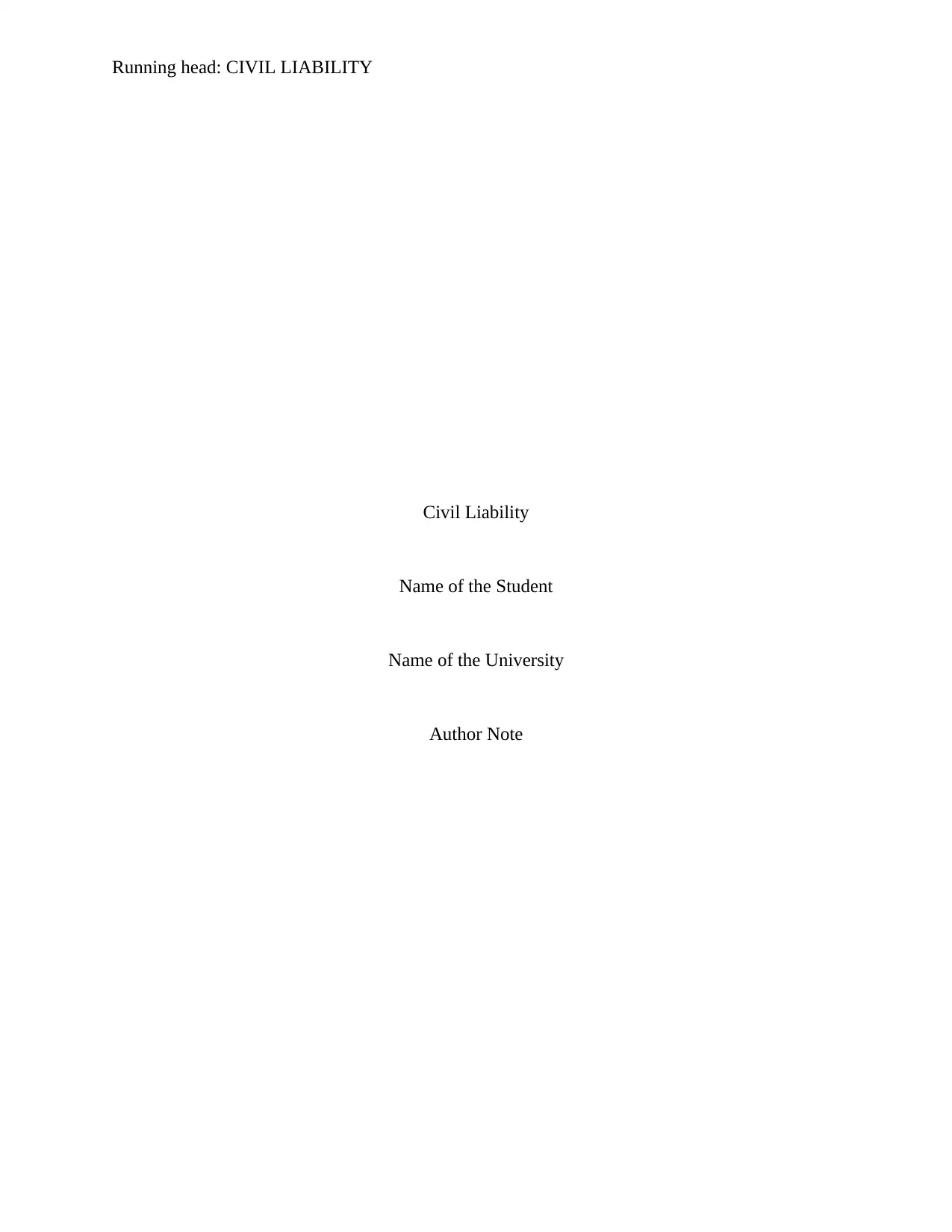
Running head: CIVIL LIABILITY
Civil Liability
Name of the Student
Name of the University
Author Note
Civil Liability
Name of the Student
Name of the University
Author Note
Paraphrase This Document
Need a fresh take? Get an instant paraphrase of this document with our AI Paraphraser
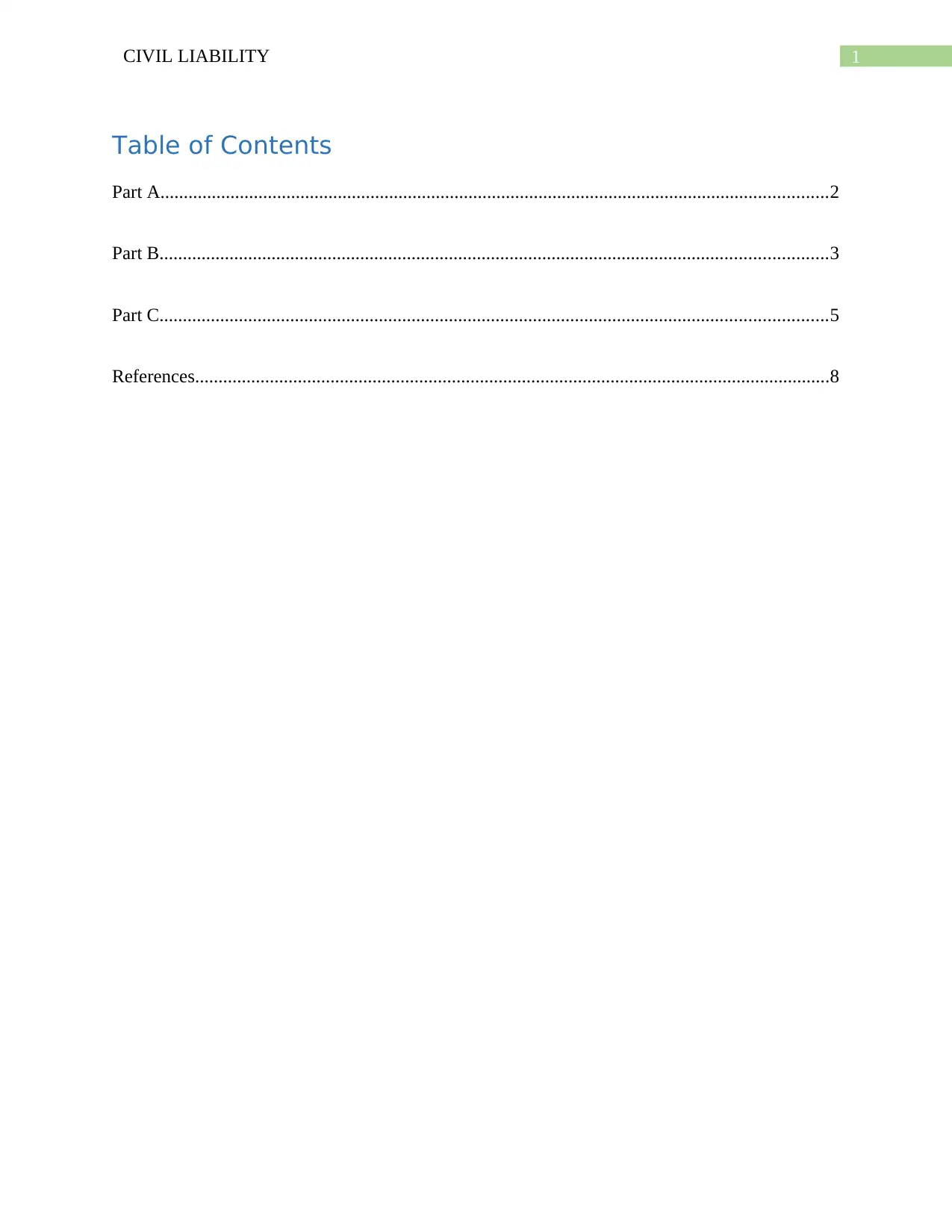
1CIVIL LIABILITY
Table of Contents
Part A...............................................................................................................................................2
Part B...............................................................................................................................................3
Part C...............................................................................................................................................5
References........................................................................................................................................8
Table of Contents
Part A...............................................................................................................................................2
Part B...............................................................................................................................................3
Part C...............................................................................................................................................5
References........................................................................................................................................8
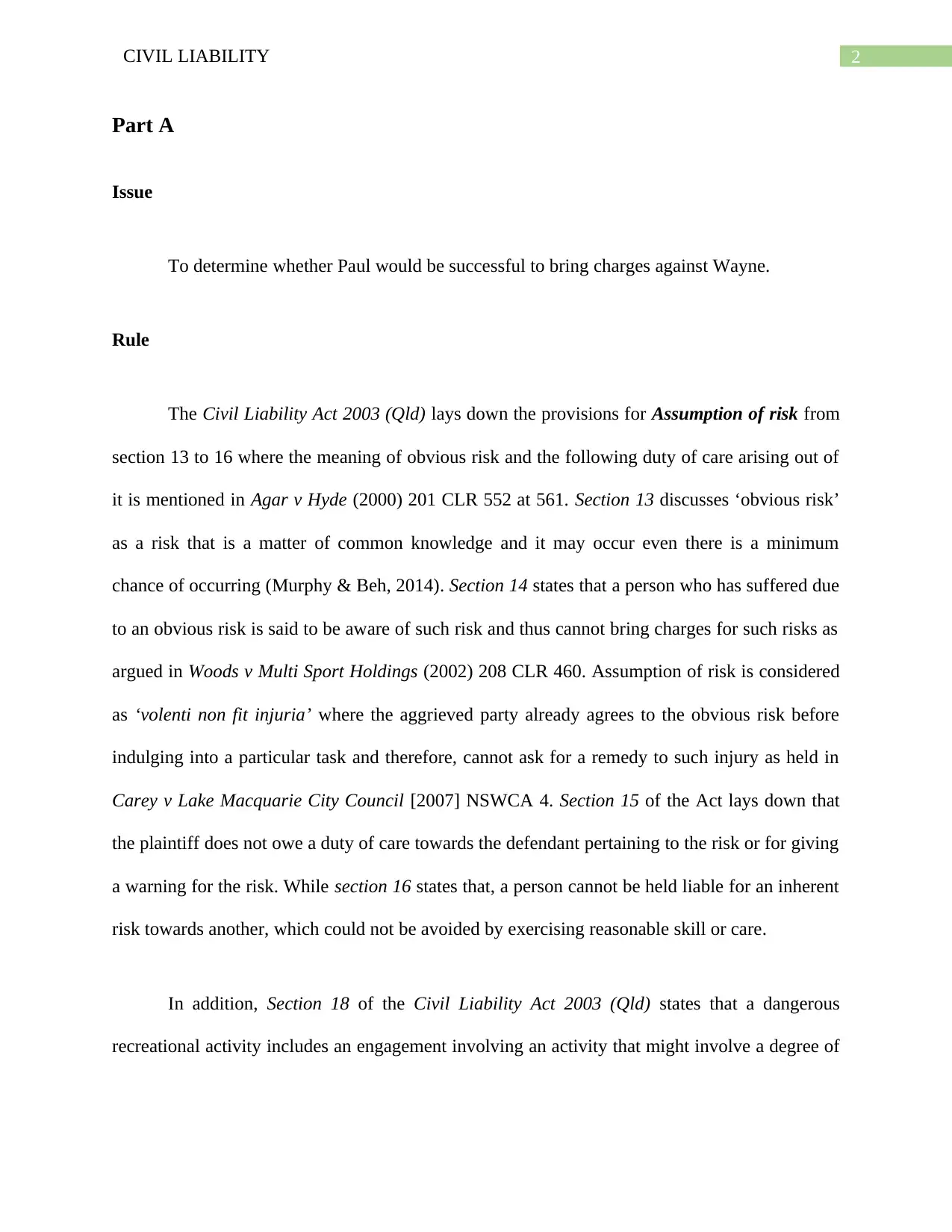
2CIVIL LIABILITY
Part A
Issue
To determine whether Paul would be successful to bring charges against Wayne.
Rule
The Civil Liability Act 2003 (Qld) lays down the provisions for Assumption of risk from
section 13 to 16 where the meaning of obvious risk and the following duty of care arising out of
it is mentioned in Agar v Hyde (2000) 201 CLR 552 at 561. Section 13 discusses ‘obvious risk’
as a risk that is a matter of common knowledge and it may occur even there is a minimum
chance of occurring (Murphy & Beh, 2014). Section 14 states that a person who has suffered due
to an obvious risk is said to be aware of such risk and thus cannot bring charges for such risks as
argued in Woods v Multi Sport Holdings (2002) 208 CLR 460. Assumption of risk is considered
as ‘volenti non fit injuria’ where the aggrieved party already agrees to the obvious risk before
indulging into a particular task and therefore, cannot ask for a remedy to such injury as held in
Carey v Lake Macquarie City Council [2007] NSWCA 4. Section 15 of the Act lays down that
the plaintiff does not owe a duty of care towards the defendant pertaining to the risk or for giving
a warning for the risk. While section 16 states that, a person cannot be held liable for an inherent
risk towards another, which could not be avoided by exercising reasonable skill or care.
In addition, Section 18 of the Civil Liability Act 2003 (Qld) states that a dangerous
recreational activity includes an engagement involving an activity that might involve a degree of
Part A
Issue
To determine whether Paul would be successful to bring charges against Wayne.
Rule
The Civil Liability Act 2003 (Qld) lays down the provisions for Assumption of risk from
section 13 to 16 where the meaning of obvious risk and the following duty of care arising out of
it is mentioned in Agar v Hyde (2000) 201 CLR 552 at 561. Section 13 discusses ‘obvious risk’
as a risk that is a matter of common knowledge and it may occur even there is a minimum
chance of occurring (Murphy & Beh, 2014). Section 14 states that a person who has suffered due
to an obvious risk is said to be aware of such risk and thus cannot bring charges for such risks as
argued in Woods v Multi Sport Holdings (2002) 208 CLR 460. Assumption of risk is considered
as ‘volenti non fit injuria’ where the aggrieved party already agrees to the obvious risk before
indulging into a particular task and therefore, cannot ask for a remedy to such injury as held in
Carey v Lake Macquarie City Council [2007] NSWCA 4. Section 15 of the Act lays down that
the plaintiff does not owe a duty of care towards the defendant pertaining to the risk or for giving
a warning for the risk. While section 16 states that, a person cannot be held liable for an inherent
risk towards another, which could not be avoided by exercising reasonable skill or care.
In addition, Section 18 of the Civil Liability Act 2003 (Qld) states that a dangerous
recreational activity includes an engagement involving an activity that might involve a degree of
⊘ This is a preview!⊘
Do you want full access?
Subscribe today to unlock all pages.

Trusted by 1+ million students worldwide
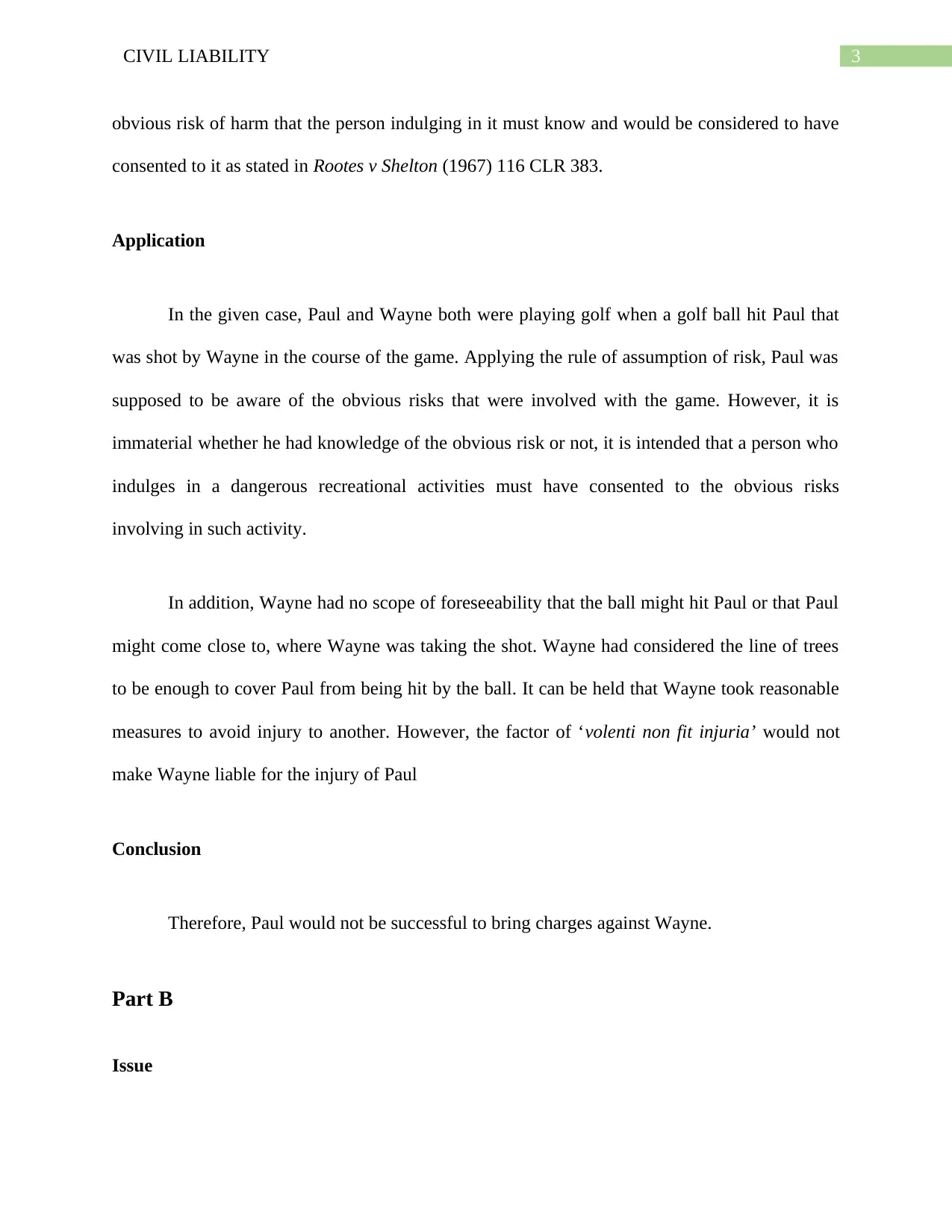
3CIVIL LIABILITY
obvious risk of harm that the person indulging in it must know and would be considered to have
consented to it as stated in Rootes v Shelton (1967) 116 CLR 383.
Application
In the given case, Paul and Wayne both were playing golf when a golf ball hit Paul that
was shot by Wayne in the course of the game. Applying the rule of assumption of risk, Paul was
supposed to be aware of the obvious risks that were involved with the game. However, it is
immaterial whether he had knowledge of the obvious risk or not, it is intended that a person who
indulges in a dangerous recreational activities must have consented to the obvious risks
involving in such activity.
In addition, Wayne had no scope of foreseeability that the ball might hit Paul or that Paul
might come close to, where Wayne was taking the shot. Wayne had considered the line of trees
to be enough to cover Paul from being hit by the ball. It can be held that Wayne took reasonable
measures to avoid injury to another. However, the factor of ‘volenti non fit injuria’ would not
make Wayne liable for the injury of Paul
Conclusion
Therefore, Paul would not be successful to bring charges against Wayne.
Part B
Issue
obvious risk of harm that the person indulging in it must know and would be considered to have
consented to it as stated in Rootes v Shelton (1967) 116 CLR 383.
Application
In the given case, Paul and Wayne both were playing golf when a golf ball hit Paul that
was shot by Wayne in the course of the game. Applying the rule of assumption of risk, Paul was
supposed to be aware of the obvious risks that were involved with the game. However, it is
immaterial whether he had knowledge of the obvious risk or not, it is intended that a person who
indulges in a dangerous recreational activities must have consented to the obvious risks
involving in such activity.
In addition, Wayne had no scope of foreseeability that the ball might hit Paul or that Paul
might come close to, where Wayne was taking the shot. Wayne had considered the line of trees
to be enough to cover Paul from being hit by the ball. It can be held that Wayne took reasonable
measures to avoid injury to another. However, the factor of ‘volenti non fit injuria’ would not
make Wayne liable for the injury of Paul
Conclusion
Therefore, Paul would not be successful to bring charges against Wayne.
Part B
Issue
Paraphrase This Document
Need a fresh take? Get an instant paraphrase of this document with our AI Paraphraser
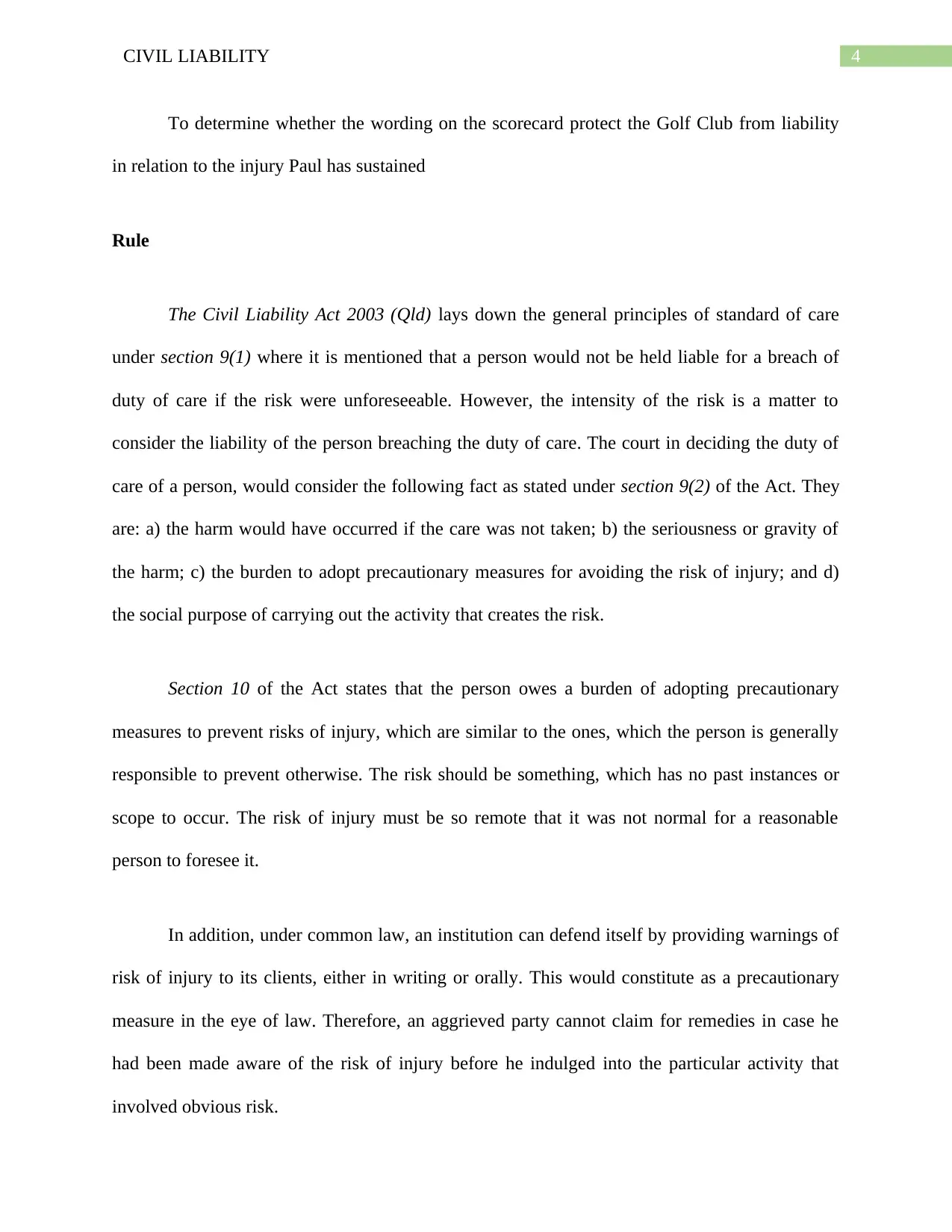
4CIVIL LIABILITY
To determine whether the wording on the scorecard protect the Golf Club from liability
in relation to the injury Paul has sustained
Rule
The Civil Liability Act 2003 (Qld) lays down the general principles of standard of care
under section 9(1) where it is mentioned that a person would not be held liable for a breach of
duty of care if the risk were unforeseeable. However, the intensity of the risk is a matter to
consider the liability of the person breaching the duty of care. The court in deciding the duty of
care of a person, would consider the following fact as stated under section 9(2) of the Act. They
are: a) the harm would have occurred if the care was not taken; b) the seriousness or gravity of
the harm; c) the burden to adopt precautionary measures for avoiding the risk of injury; and d)
the social purpose of carrying out the activity that creates the risk.
Section 10 of the Act states that the person owes a burden of adopting precautionary
measures to prevent risks of injury, which are similar to the ones, which the person is generally
responsible to prevent otherwise. The risk should be something, which has no past instances or
scope to occur. The risk of injury must be so remote that it was not normal for a reasonable
person to foresee it.
In addition, under common law, an institution can defend itself by providing warnings of
risk of injury to its clients, either in writing or orally. This would constitute as a precautionary
measure in the eye of law. Therefore, an aggrieved party cannot claim for remedies in case he
had been made aware of the risk of injury before he indulged into the particular activity that
involved obvious risk.
To determine whether the wording on the scorecard protect the Golf Club from liability
in relation to the injury Paul has sustained
Rule
The Civil Liability Act 2003 (Qld) lays down the general principles of standard of care
under section 9(1) where it is mentioned that a person would not be held liable for a breach of
duty of care if the risk were unforeseeable. However, the intensity of the risk is a matter to
consider the liability of the person breaching the duty of care. The court in deciding the duty of
care of a person, would consider the following fact as stated under section 9(2) of the Act. They
are: a) the harm would have occurred if the care was not taken; b) the seriousness or gravity of
the harm; c) the burden to adopt precautionary measures for avoiding the risk of injury; and d)
the social purpose of carrying out the activity that creates the risk.
Section 10 of the Act states that the person owes a burden of adopting precautionary
measures to prevent risks of injury, which are similar to the ones, which the person is generally
responsible to prevent otherwise. The risk should be something, which has no past instances or
scope to occur. The risk of injury must be so remote that it was not normal for a reasonable
person to foresee it.
In addition, under common law, an institution can defend itself by providing warnings of
risk of injury to its clients, either in writing or orally. This would constitute as a precautionary
measure in the eye of law. Therefore, an aggrieved party cannot claim for remedies in case he
had been made aware of the risk of injury before he indulged into the particular activity that
involved obvious risk.
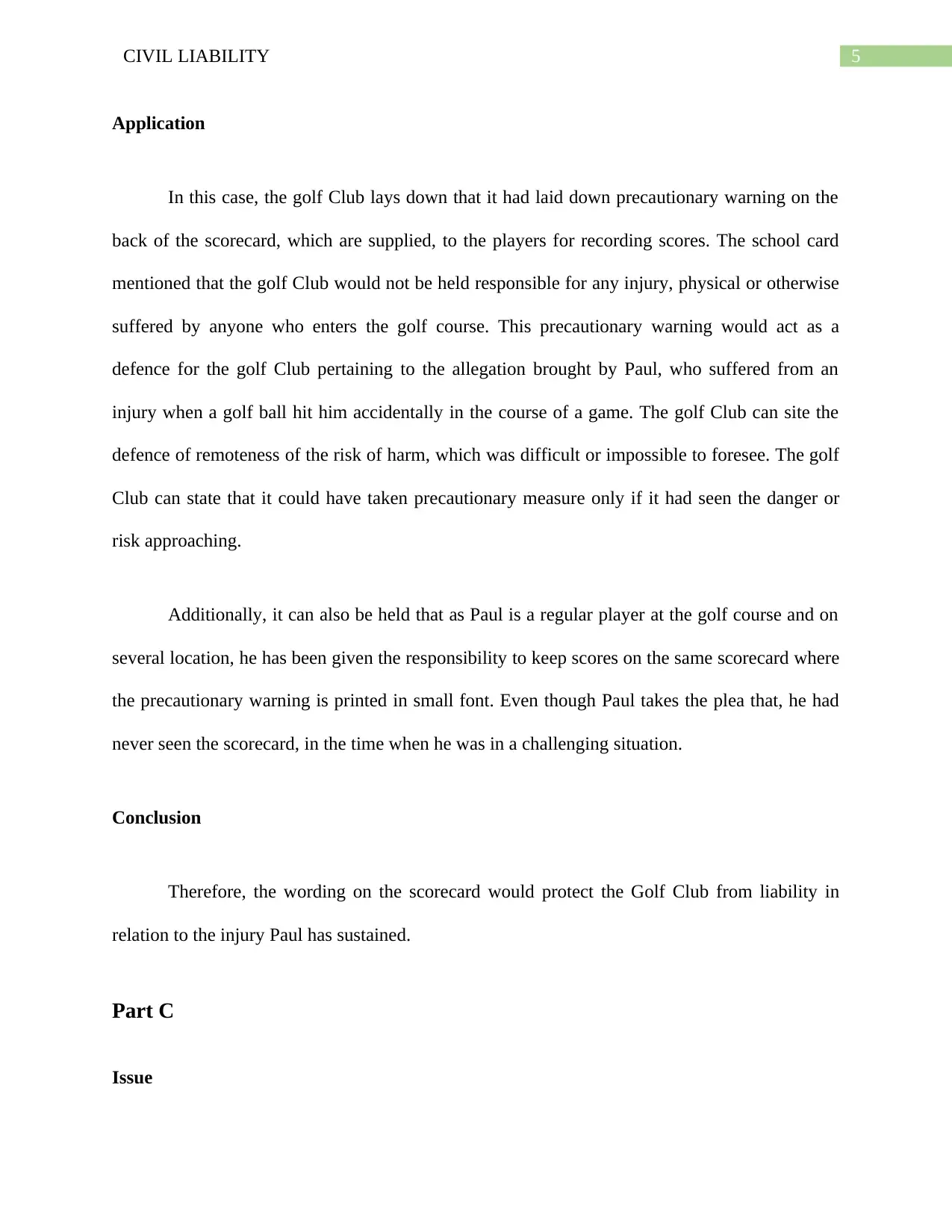
5CIVIL LIABILITY
Application
In this case, the golf Club lays down that it had laid down precautionary warning on the
back of the scorecard, which are supplied, to the players for recording scores. The school card
mentioned that the golf Club would not be held responsible for any injury, physical or otherwise
suffered by anyone who enters the golf course. This precautionary warning would act as a
defence for the golf Club pertaining to the allegation brought by Paul, who suffered from an
injury when a golf ball hit him accidentally in the course of a game. The golf Club can site the
defence of remoteness of the risk of harm, which was difficult or impossible to foresee. The golf
Club can state that it could have taken precautionary measure only if it had seen the danger or
risk approaching.
Additionally, it can also be held that as Paul is a regular player at the golf course and on
several location, he has been given the responsibility to keep scores on the same scorecard where
the precautionary warning is printed in small font. Even though Paul takes the plea that, he had
never seen the scorecard, in the time when he was in a challenging situation.
Conclusion
Therefore, the wording on the scorecard would protect the Golf Club from liability in
relation to the injury Paul has sustained.
Part C
Issue
Application
In this case, the golf Club lays down that it had laid down precautionary warning on the
back of the scorecard, which are supplied, to the players for recording scores. The school card
mentioned that the golf Club would not be held responsible for any injury, physical or otherwise
suffered by anyone who enters the golf course. This precautionary warning would act as a
defence for the golf Club pertaining to the allegation brought by Paul, who suffered from an
injury when a golf ball hit him accidentally in the course of a game. The golf Club can site the
defence of remoteness of the risk of harm, which was difficult or impossible to foresee. The golf
Club can state that it could have taken precautionary measure only if it had seen the danger or
risk approaching.
Additionally, it can also be held that as Paul is a regular player at the golf course and on
several location, he has been given the responsibility to keep scores on the same scorecard where
the precautionary warning is printed in small font. Even though Paul takes the plea that, he had
never seen the scorecard, in the time when he was in a challenging situation.
Conclusion
Therefore, the wording on the scorecard would protect the Golf Club from liability in
relation to the injury Paul has sustained.
Part C
Issue
⊘ This is a preview!⊘
Do you want full access?
Subscribe today to unlock all pages.

Trusted by 1+ million students worldwide
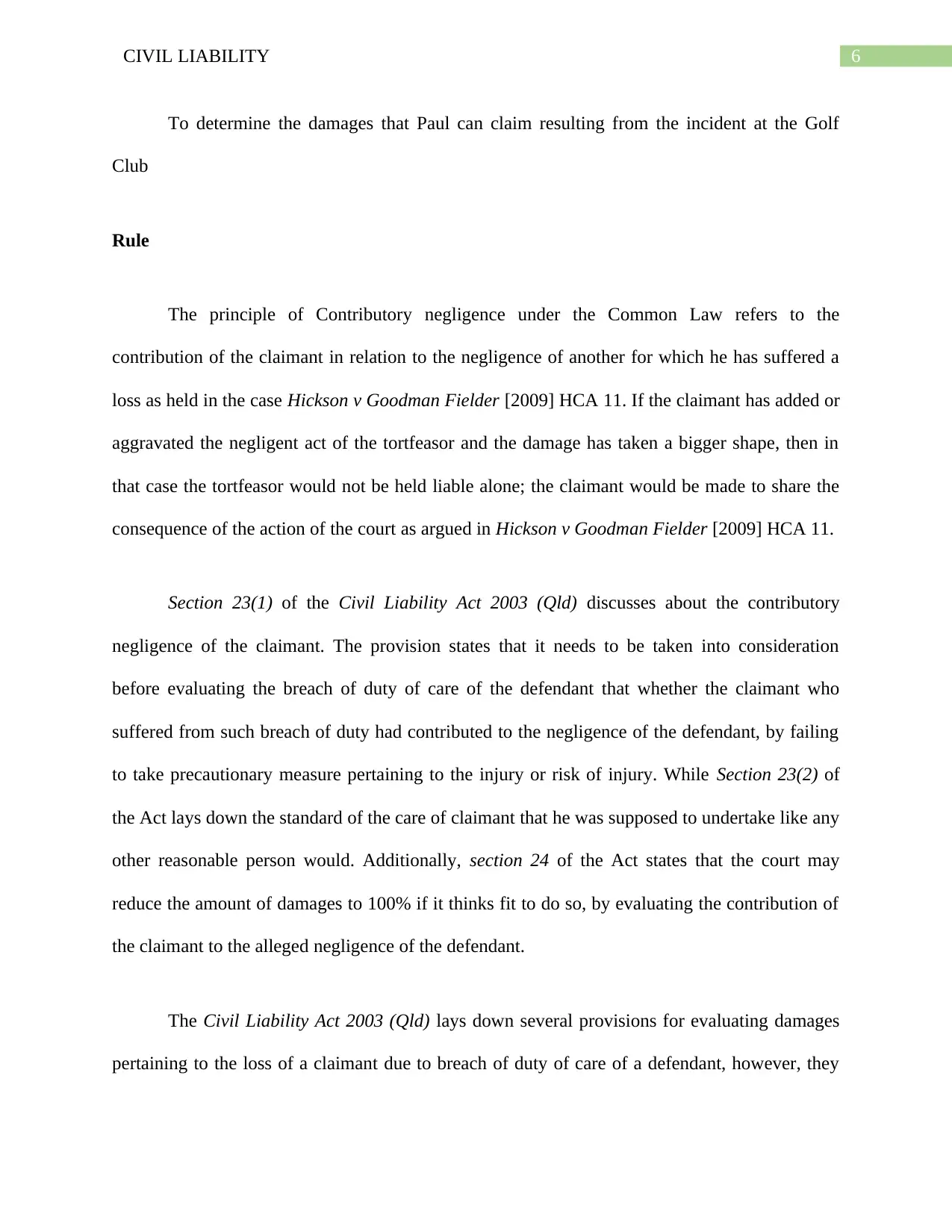
6CIVIL LIABILITY
To determine the damages that Paul can claim resulting from the incident at the Golf
Club
Rule
The principle of Contributory negligence under the Common Law refers to the
contribution of the claimant in relation to the negligence of another for which he has suffered a
loss as held in the case Hickson v Goodman Fielder [2009] HCA 11. If the claimant has added or
aggravated the negligent act of the tortfeasor and the damage has taken a bigger shape, then in
that case the tortfeasor would not be held liable alone; the claimant would be made to share the
consequence of the action of the court as argued in Hickson v Goodman Fielder [2009] HCA 11.
Section 23(1) of the Civil Liability Act 2003 (Qld) discusses about the contributory
negligence of the claimant. The provision states that it needs to be taken into consideration
before evaluating the breach of duty of care of the defendant that whether the claimant who
suffered from such breach of duty had contributed to the negligence of the defendant, by failing
to take precautionary measure pertaining to the injury or risk of injury. While Section 23(2) of
the Act lays down the standard of the care of claimant that he was supposed to undertake like any
other reasonable person would. Additionally, section 24 of the Act states that the court may
reduce the amount of damages to 100% if it thinks fit to do so, by evaluating the contribution of
the claimant to the alleged negligence of the defendant.
The Civil Liability Act 2003 (Qld) lays down several provisions for evaluating damages
pertaining to the loss of a claimant due to breach of duty of care of a defendant, however, they
To determine the damages that Paul can claim resulting from the incident at the Golf
Club
Rule
The principle of Contributory negligence under the Common Law refers to the
contribution of the claimant in relation to the negligence of another for which he has suffered a
loss as held in the case Hickson v Goodman Fielder [2009] HCA 11. If the claimant has added or
aggravated the negligent act of the tortfeasor and the damage has taken a bigger shape, then in
that case the tortfeasor would not be held liable alone; the claimant would be made to share the
consequence of the action of the court as argued in Hickson v Goodman Fielder [2009] HCA 11.
Section 23(1) of the Civil Liability Act 2003 (Qld) discusses about the contributory
negligence of the claimant. The provision states that it needs to be taken into consideration
before evaluating the breach of duty of care of the defendant that whether the claimant who
suffered from such breach of duty had contributed to the negligence of the defendant, by failing
to take precautionary measure pertaining to the injury or risk of injury. While Section 23(2) of
the Act lays down the standard of the care of claimant that he was supposed to undertake like any
other reasonable person would. Additionally, section 24 of the Act states that the court may
reduce the amount of damages to 100% if it thinks fit to do so, by evaluating the contribution of
the claimant to the alleged negligence of the defendant.
The Civil Liability Act 2003 (Qld) lays down several provisions for evaluating damages
pertaining to the loss of a claimant due to breach of duty of care of a defendant, however, they
Paraphrase This Document
Need a fresh take? Get an instant paraphrase of this document with our AI Paraphraser
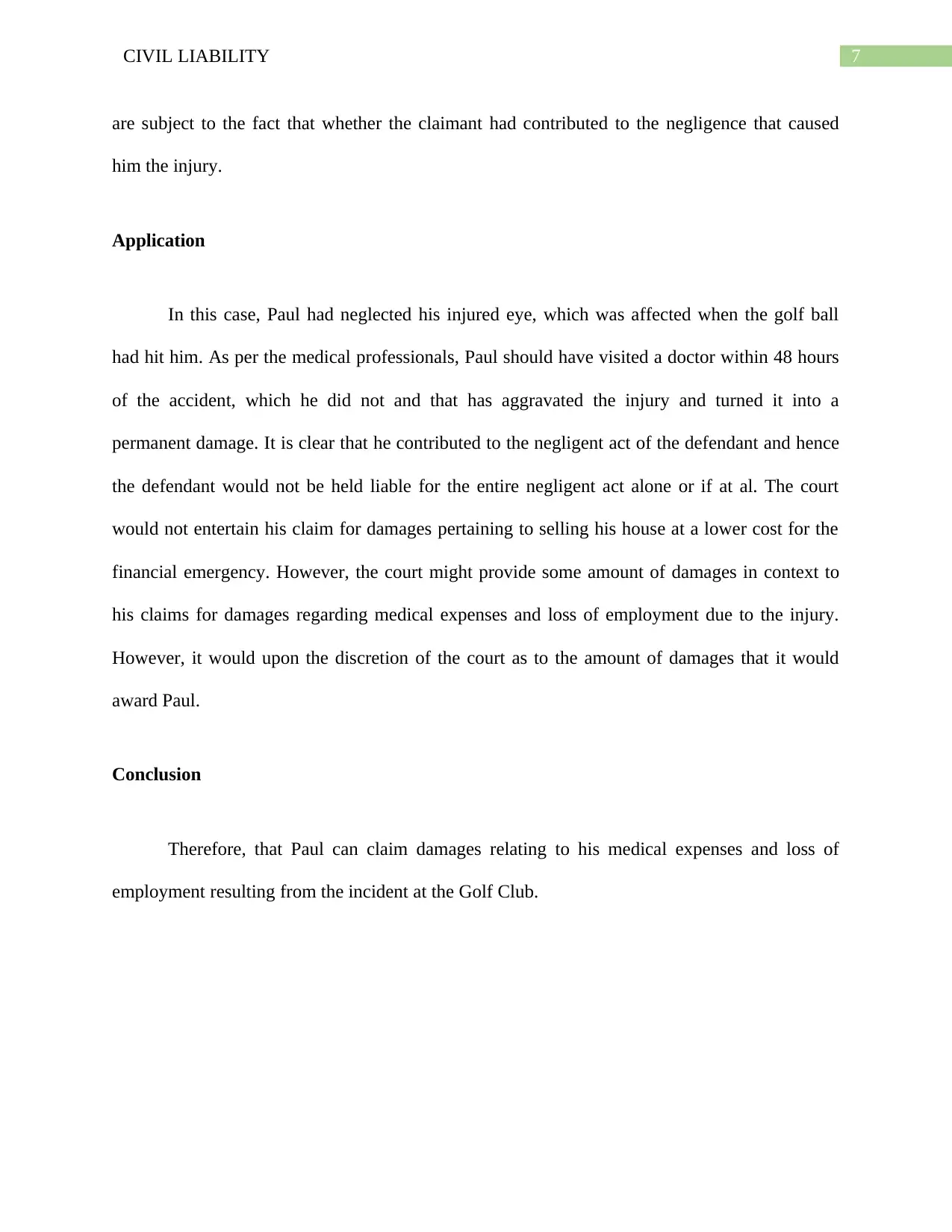
7CIVIL LIABILITY
are subject to the fact that whether the claimant had contributed to the negligence that caused
him the injury.
Application
In this case, Paul had neglected his injured eye, which was affected when the golf ball
had hit him. As per the medical professionals, Paul should have visited a doctor within 48 hours
of the accident, which he did not and that has aggravated the injury and turned it into a
permanent damage. It is clear that he contributed to the negligent act of the defendant and hence
the defendant would not be held liable for the entire negligent act alone or if at al. The court
would not entertain his claim for damages pertaining to selling his house at a lower cost for the
financial emergency. However, the court might provide some amount of damages in context to
his claims for damages regarding medical expenses and loss of employment due to the injury.
However, it would upon the discretion of the court as to the amount of damages that it would
award Paul.
Conclusion
Therefore, that Paul can claim damages relating to his medical expenses and loss of
employment resulting from the incident at the Golf Club.
are subject to the fact that whether the claimant had contributed to the negligence that caused
him the injury.
Application
In this case, Paul had neglected his injured eye, which was affected when the golf ball
had hit him. As per the medical professionals, Paul should have visited a doctor within 48 hours
of the accident, which he did not and that has aggravated the injury and turned it into a
permanent damage. It is clear that he contributed to the negligent act of the defendant and hence
the defendant would not be held liable for the entire negligent act alone or if at al. The court
would not entertain his claim for damages pertaining to selling his house at a lower cost for the
financial emergency. However, the court might provide some amount of damages in context to
his claims for damages regarding medical expenses and loss of employment due to the injury.
However, it would upon the discretion of the court as to the amount of damages that it would
award Paul.
Conclusion
Therefore, that Paul can claim damages relating to his medical expenses and loss of
employment resulting from the incident at the Golf Club.
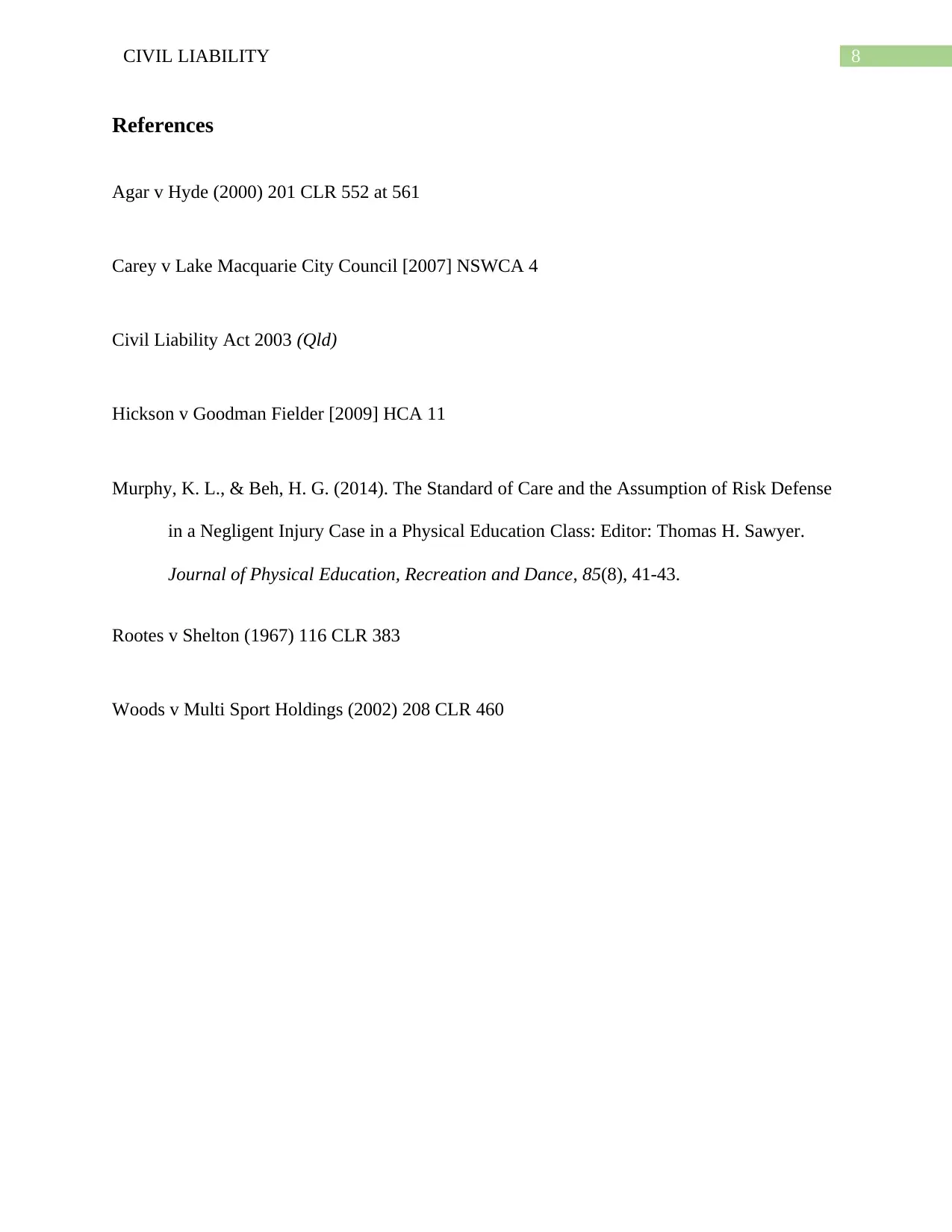
8CIVIL LIABILITY
References
Agar v Hyde (2000) 201 CLR 552 at 561
Carey v Lake Macquarie City Council [2007] NSWCA 4
Civil Liability Act 2003 (Qld)
Hickson v Goodman Fielder [2009] HCA 11
Murphy, K. L., & Beh, H. G. (2014). The Standard of Care and the Assumption of Risk Defense
in a Negligent Injury Case in a Physical Education Class: Editor: Thomas H. Sawyer.
Journal of Physical Education, Recreation and Dance, 85(8), 41-43.
Rootes v Shelton (1967) 116 CLR 383
Woods v Multi Sport Holdings (2002) 208 CLR 460
References
Agar v Hyde (2000) 201 CLR 552 at 561
Carey v Lake Macquarie City Council [2007] NSWCA 4
Civil Liability Act 2003 (Qld)
Hickson v Goodman Fielder [2009] HCA 11
Murphy, K. L., & Beh, H. G. (2014). The Standard of Care and the Assumption of Risk Defense
in a Negligent Injury Case in a Physical Education Class: Editor: Thomas H. Sawyer.
Journal of Physical Education, Recreation and Dance, 85(8), 41-43.
Rootes v Shelton (1967) 116 CLR 383
Woods v Multi Sport Holdings (2002) 208 CLR 460
⊘ This is a preview!⊘
Do you want full access?
Subscribe today to unlock all pages.

Trusted by 1+ million students worldwide
1 out of 9
Your All-in-One AI-Powered Toolkit for Academic Success.
+13062052269
info@desklib.com
Available 24*7 on WhatsApp / Email
![[object Object]](/_next/static/media/star-bottom.7253800d.svg)
Unlock your academic potential
Copyright © 2020–2025 A2Z Services. All Rights Reserved. Developed and managed by ZUCOL.
